How to Raise Backyard Chickens: A Complete Guide
Raising backyard chickens has become a popular trend in recent years. Not only do they provide fresh eggs, but they also make great pets and can even help with pest control in your yard.
However, if you’re new to chicken keeping, it can be overwhelming to know where to start. That’s why we’ve put together this complete guide on how to raise backyard chickens.
We have had chickens in our backyard for over ten years and will be starting our fifth flock next spring.
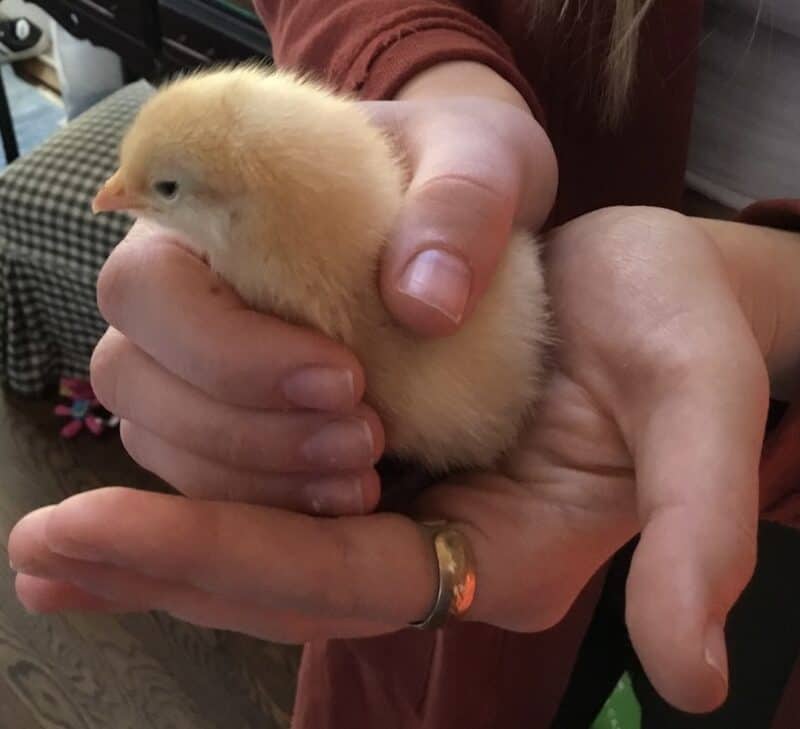
On my blog Living Large in A Small House, I may sometimes use affiliate links, which means a small commission is earned if you purchase via the link. The price will be the same whether you use the affiliate link or go directly to the vendor’s website using a non-affiliate link. You can find my full Disclosure Policy HERE
Are you Considering Raising Backyard Chickens?
First, it’s important to choose the right breed of chicken for your needs. Some breeds are better for egg production, while others are more docile and make better pets. We’ll go over some of the most popular breeds and their characteristics to help you make an informed decision. Next, we’ll cover the basics of setting up a coop and run for your chickens, including size requirements and necessary equipment.
Finally, we’ll dive into the day-to-day care of your chickens, including feeding, watering, and cleaning. We’ll also discuss common health issues and how to prevent and treat them. By the end of this guide, you’ll have all the information you need to successfully raise your own backyard chickens.
Getting Started with Backyard Chickens
Raising backyard chickens can be a fun and rewarding experience. However, before diving into this new adventure, there are a few things we need to consider.
Understanding Local Ordinances
The first step in raising backyard chickens is to understand local ordinances. Some cities and towns have regulations regarding the number of chickens you can keep and the size of your coop. It’s important to research and understand these regulations before bringing home your new feathered friends. You may also need a permit to build your chicken coop.
In our case we can only have 7 hens; no roosters are allowed. We can’t sell the eggs or slaughter our chickens. So we only have good egg-laying breeds. When we have more eggs than we can consume, we share them with our friends and neighbors.
Choosing the Right Breed
Choosing the right breed of chicken is also an important step. Some breeds are better suited for egg production, while others are better for meat. It’s important to consider the climate in your area and choose a breed that is well-suited for your region. Some popular breeds for backyard chickens include Rhode Island Reds, Plymouth Rocks, and Leghorns. I also like Americana’s because they produce the pretty blue/green eggs but our experience with them is that they can tend to be a little aggressive.
The first thing you need to do is your research to chose the right breed of chicken for your backyard chickens. Here are our criteria:
- We wanted different breeds of hens
- We wanted different colored eggs (green/blue/brown/peach/white)
- It’s important for us in Illinois to choose hens that can survive in the cold winter months (yes, they stay outside all year long)
- Friendly temperament was also a big consideration
- We wanted birds that are known for good egg production
- Some backyard chicken owners can use their chickens for things other than egg-laying, so you might consider dual-purpose breeds. There are breeds that are not only egg layers but also meat birds.
We have had all of the following at some point. We loved them all but we especially loved the Buff Orpingtons because they were super friendly and interactive with us, however, because they were so sweet they both were victims of raccoons.
- Rhode Island Reds
- Barred Rock
- Ameraucana – Often called Easter Eggers (They lay the blue and green eggs) but we’ve found they can be a bit aggressive.
- Australorp
- Leghorns
- Welssummers
- Buff Orpington
- Wyandotte
- Dominique
- Plymouth Rock
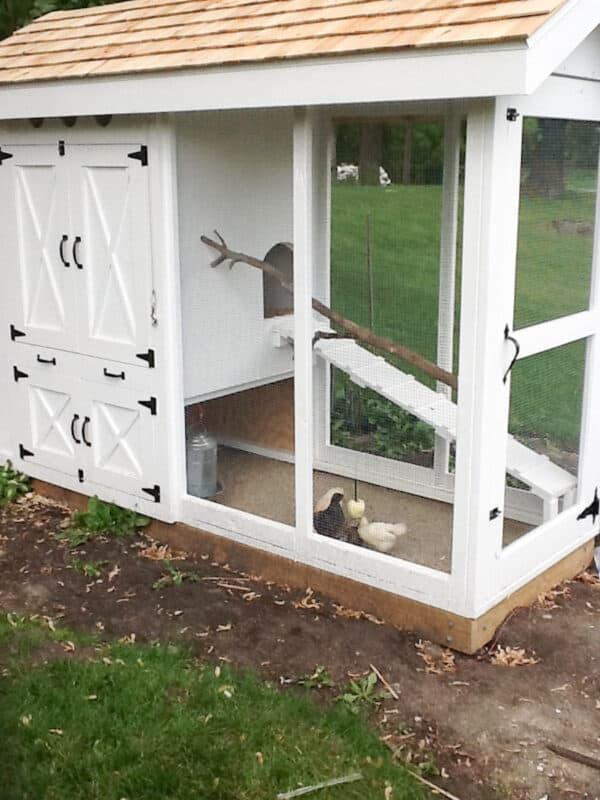
Setting Up Your Chicken Coop
The backyard chicken coop is where your chickens will spend most of their time. It’s important to set up a comfortable and safe environment for your birds. The coop should be large enough to accommodate all of your chickens, with enough space for them to move around freely. The rule of thumb should be 4 square feet of coop space and 8 square feet of run for each bird.
It should also be secure, to protect your birds from predators. We made a base for the coop to sit on. It’s made of 2″ x 6″ wood and we added 1/2″ x 1/2″ galvanized wire to the complete underside of the base. This part is important as we have minks and other small animals who can burrow into the ground and get into the coop if it’s not protected.
In conclusion, raising backyard chickens can be a fun and rewarding experience. However, it’s important to do your research and understand local regulations before getting started. Choosing the right breed of chicken and setting up a comfortable and secure coop are also important factors to consider.
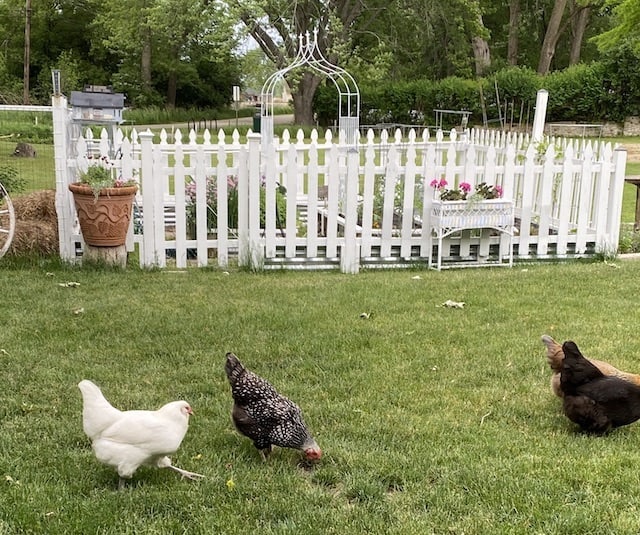
Caring for Baby Chicks
Raising baby chicks can be a rewarding experience, but it requires proper care and attention. In this section, we will discuss the essential steps to care for baby chicks.
Preparing for Arrival
Before the arrival of your baby chicks, it is essential to prepare a suitable brooder. A brooder is a warm and safe space for your chicks to grow and develop. You can use a cardboard box or a plastic container as a brooder. We have always used a galvanized tub. Make sure to line the bottom with a layer of clean and dry bedding, such as pine shavings or straw.
Next, you need to set up a heat lamp to maintain a warm temperature in the brooder. Baby chicks require a temperature of around 95°F in the first week of their life. You can adjust the height of the heat lamp to regulate the temperature. It is crucial to monitor the temperature regularly using a thermometer.
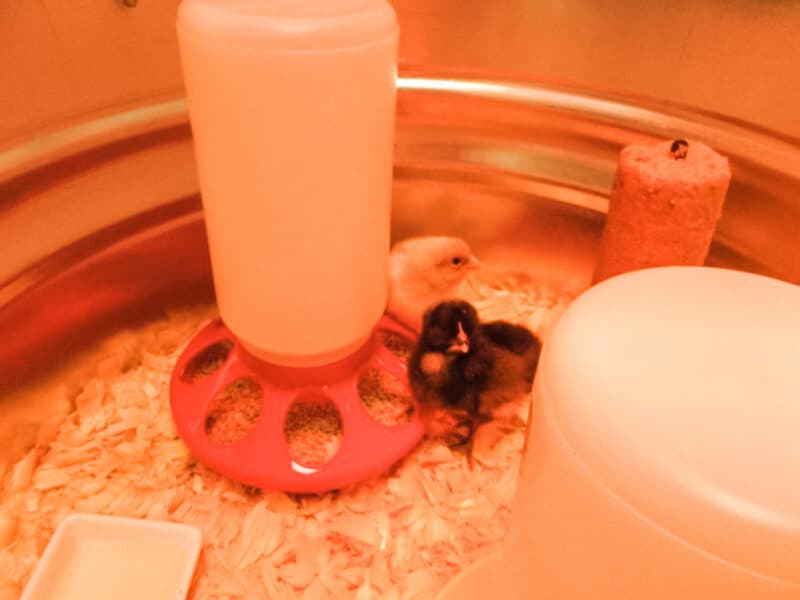
First Week Essentials
The first week of a chick’s life is critical for its growth and development. During this period, you need to ensure that your chicks have access to clean water and chick starter feed. You can use a shallow dish for water and a chick feeder for feed. Make sure to change the water and refill the feeder daily. I also add electrolytes to our chicks’ water. Especially the first days when they were stressed and then any time that I felt like they needed a little help.
You also need to keep the brooder clean and dry. Remove any wet or soiled bedding and replace it with fresh bedding. This will prevent the growth of bacteria and keep your chicks healthy. The first week I made sure that I was home most of the time to keep a really close eye on them.
If you have pets or small children, you must ensure they are kept apart. When our chicks were very young they lived in our laundry room. As they got bigger we moved them to a larger cage that we made to house them and we kept them in the dining room
Our timing has always been that we get day-old chicks in mid-April and then they are out of the house and in the coop in late May, or early June.
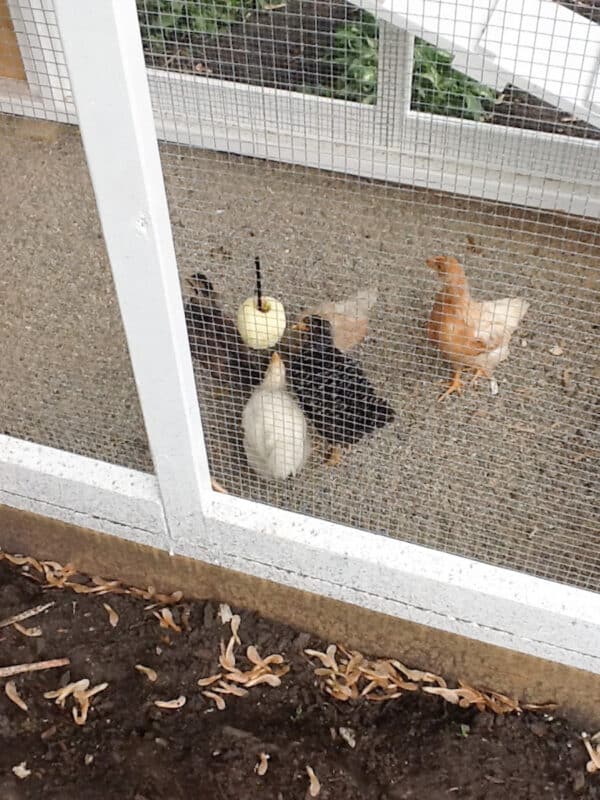
Growth and Development
When you bring new born chicks home they need to be monitored pretty often. I made sure to clear my. calendar for the first weeks so I wasn’t away from them for too long. You need to make sure they are getting enough warmth, water, food, and plenty of attention in the beginning.
In the first few days if they were all hovering under the lamp all the time, they might be a little cold and your lamp might be too high. If they are all moved away from the light it might be too low. We don’t want to cook the little ones. 18″ – 20″ above their living space is a good starting point.
As your chicks grow, you need to adjust the temperature in the brooder gradually. Reduce the temperature by 5°F every week until your chicks are four weeks old. At this point, they can regulate their body temperature and no longer require a heat lamp.
You also need to provide your chicks with enough space to move around and exercise. As a general rule, you need at least 2 square feet of space per chick. You can gradually increase the space as your chicks grow.
In conclusion, caring for baby chicks requires proper preparation, attention, and care. By following these essential steps, you can ensure that your chicks grow and develop into healthy adult chickens.
Around 6 weeks old we put them out into the coop and did provide a heat lamp for a while until they were a little older and it was consistently warmer at night.
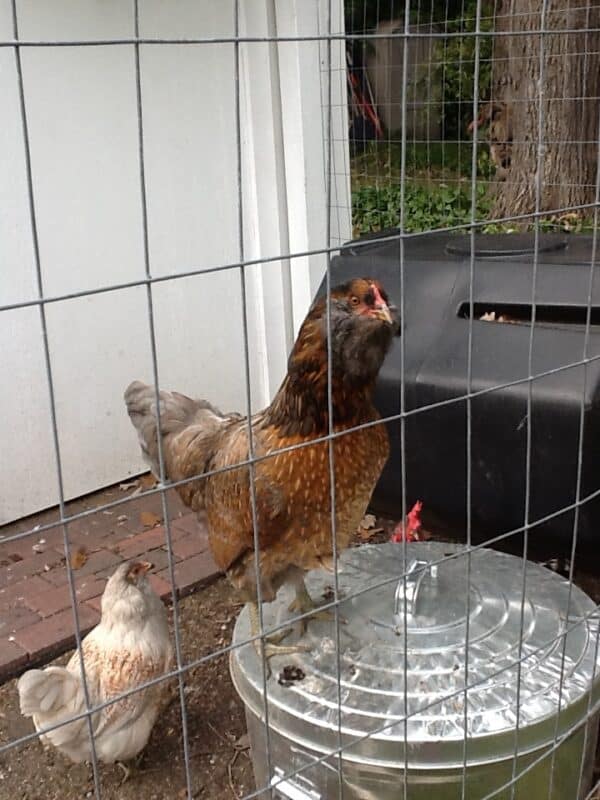
Daily Maintenance and Health
As backyard chicken owners, we know that our feathered friends require daily maintenance and care to ensure their health and happiness. In this section, we will cover the three main aspects of daily maintenance: feeding and nutrition, cleanliness and hygiene, and monitoring health and behavior.
Feeding and Nutrition
Providing our chickens with a balanced diet is essential for their overall health and egg production. We make sure to offer our chickens a high-quality commercial feed that is specifically formulated for their needs. Additionally, we supplement their diet with fresh fruits and vegetables, such as leafy greens and berries, to ensure they receive a variety of nutrients.
It’s important to always provide fresh water for our chickens. We make sure to clean and refill their water daily to prevent any potential health problems.
Cleanliness and Hygiene
Maintaining a clean and hygienic coop is crucial for our chickens’ health. We make sure to clean out their coop and nesting boxes regularly, removing any soiled bedding and replacing it with fresh, clean bedding. We also ensure that their coop is well-ventilated to prevent the buildup of harmful gases.
We monitor our chickens for any signs of pasty butt, a condition where feces sticks to the vent area and can cause blockages. If we notice any issues, we clean the affected area and make sure to adjust their diet or environment to prevent it from happening again.
Be mindful of proper gear when dealing with chicken poop. Use glasses or googles, rubber gloves and I also strongly recommend a face mask. I got salmonella from cleaning a baby chicks sticky butt and it wasn’t fun. But in all the years we’ve had chicks, its the one and only time we’ve had any kind of issues.
Monitoring Health and Behavior
Regularly monitoring our chickens’ health and behavior is important for catching any potential issues early on. We keep an eye out for any signs of illness, such as lethargy, loss of appetite, or changes in their droppings. If we notice anything concerning, we consult with a veterinarian who specializes in poultry to ensure our chickens receive the proper care.
By following these daily maintenance and health practices, we can ensure our backyard chickens lead happy and healthy lives.
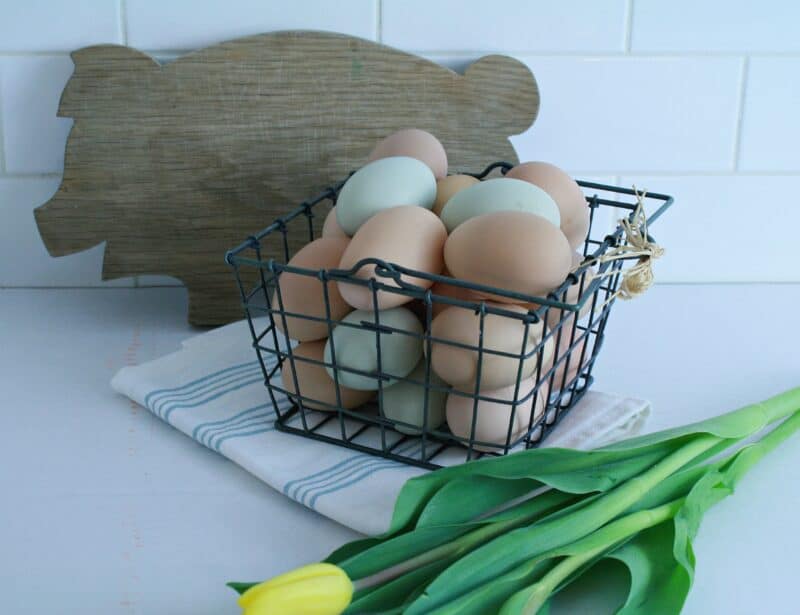
Egg Production Essentials
Understanding Egg-Laying
When it comes to egg production, it’s important to understand that not all hens are created equal. Some breeds are better at laying eggs than others, and even within a breed, individual hens may lay more or less frequently.
Additionally, hens typically start laying eggs at around 5-6 months of age and will continue to do so for several years. However, their egg production will gradually decline over time.
Our experience has been that our ladies lay about an egg a day in the spring and summer months and then in the colder months their production slows down and in some hens stops until the following spring.
To ensure optimal egg-laying, it’s important to provide your hens with a comfortable and stress-free environment. This includes providing them with a clean and spacious coop, as well as a balanced diet that includes plenty of protein and calcium.
As they get older their egg productions slows down and will evenually stop. Our current ladies haven’t laid any eggs in probably 8 months. They are about 5 years old.
Maximizing Egg Quality
If you’re raising backyard chickens, chances are you’re doing so in part because you want to enjoy fresh, delicious eggs. To maximize the quality of your eggs, there are a few key things to keep in mind.
First, make sure your hens have access to oyster shells or another source of calcium. This will help ensure that their eggshells are strong and durable.
Second, keep your coop clean and well-ventilated. Dirty or cramped living conditions can lead to bacterial infections, which can affect the quality of your eggs.
Finally, consider supplementing your hens’ diet with additional nutrients such as omega-3 fatty acids, which can help improve the nutritional content of their eggs.

Collecting and Storing Eggs
Once your hens start laying eggs, it’s important to collect them regularly to ensure they stay fresh and safe to eat. Ideally, you should collect your eggs at least once a day.
When collecting eggs, handle them gently to avoid cracking the shells. You can also use a clean, damp cloth to wipe off any dirt or debris.
If you don’t wash your eggs they can be stored on your counter for weeks. If they are washed you must store them in the refrigerator. There is a protective coating on eggs that prevents them from absorbing bacteria. Once you wash them that protection is gone. We avoid washing them until we are ready to use them.
By following these egg production essentials, you can enjoy fresh, delicious eggs from your own backyard hens.
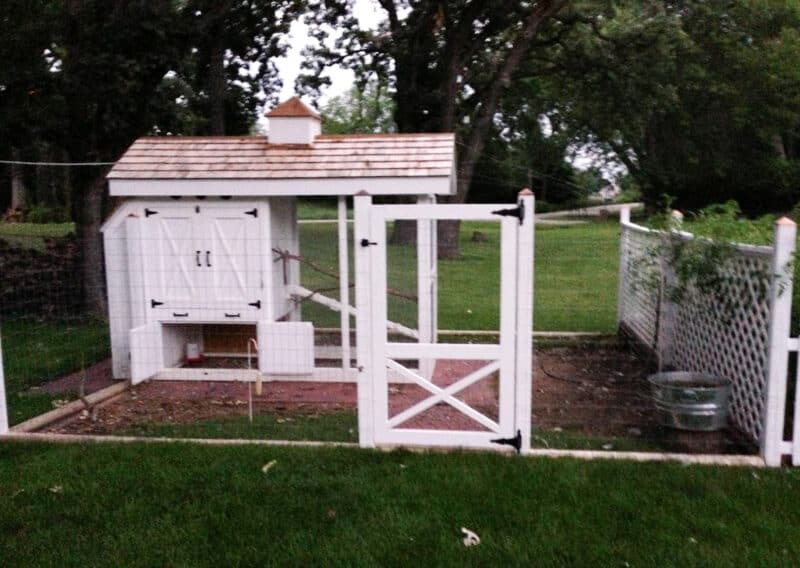
Chicken Coop Management
When it comes to raising backyard chickens, ensuring proper management of the chicken coop is crucial to the health and well-being of your birds. Here are some tips on how to effectively manage your chicken coop:
Coop Design and Space Requirements
First and foremost, it is important to have a well-designed chicken coop that meets the space requirements of your birds. A good rule of thumb is to provide at least 4 square feet of floor space per chicken, and at least 10 square feet of outdoor space in a chicken run. The coop should also have good ventilation to prevent the buildup of moisture and ammonia, which can lead to respiratory problems in chickens.

Safety and Protection
The chicken coop should be a safe place for your birds to live. This means using sturdy materials such as chicken wire to prevent predators from getting in, and ensuring that the coop is securely locked at night. Nest boxes should also be provided for your hens to lay their eggs in a safe and comfortable environment.
Coop Upkeep and Improvements
Regular upkeep of the chicken coop is necessary to keep it clean and in good condition. This includes cleaning out the coop and replacing bedding material on a regular basis, as well as making any necessary repairs to the structure. Additionally, making improvements to the coop such as adding insulation or a heat lamp can help keep your birds comfortable in colder weather.
If you are new to raising backyard chickens, it can be helpful to consult with a local farmer or other experienced chicken owner for guidance on coop management. With proper management, your chicken coop can provide a safe and comfortable home for your birds for years to come.

Dealing with Common Challenges
Raising backyard chickens can be a rewarding experience, but it also comes with its fair share of challenges. Here are some common issues that you may encounter and how to deal with them.
Predators and Pests
Predators such as raccoons, foxes, and coyotes can be a major problem for backyard chickens. To keep your flock safe, make sure your coop is secure and predator-proof. This means using sturdy materials and ensuring that there are no gaps or holes that predators can squeeze through. Additionally, consider using motion-activated lights and sound deterrents to scare off potential predators.
Pests such as mites and lice can also be a problem for chickens. To prevent infestations, provide your chickens with a dust bath area filled with sand or dirt. You can also use diatomaceous earth, a natural pest control product, to help keep your chickens free of pests.
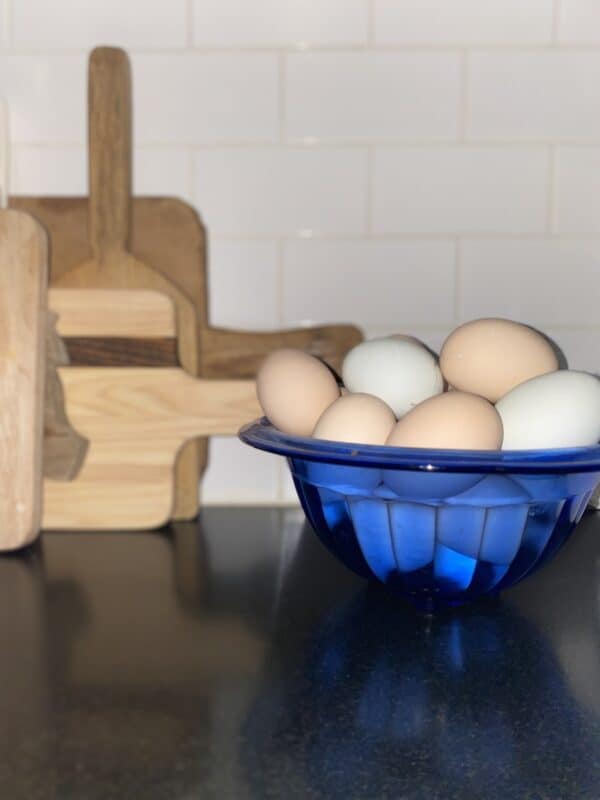
Weather and Seasonal Concerns
Cold weather can be tough on chickens, especially if they are not acclimated to the cold. To keep your chickens warm during the winter months, provide them with a well-insulated coop. We also provide a ceramic heat emitter that is on a thermostat. It’s also important to make sure your chickens have access to fresh water at all times. In the winter we place their water source on a heated base.
During the summer months, chickens may be at risk of heat stroke. To keep your chickens cool, provide them with plenty of shade and make sure they have access to fresh, cool water at all times.
Behavioral Issues
Chickens have a natural pecking order and can sometimes become aggressive towards each other. To prevent this, make sure your chickens have plenty of space and provide them with toys such as hanging cabbage or a chicken swing to keep them occupied. It’s also important to ensure that your chickens have access to plenty of food and fresh water to prevent fights over resources.
Wild birds and small animals can also be a problem for backyard chickens. To prevent these animals from stealing your chickens’ food or eggs, consider using a secure feeder and nesting boxes. You can also use netting or fencing to keep wild birds and animals out of your chicken coop.
Raising backyard chickens can be a fun and rewarding experience, but it’s important to be prepared for the challenges that may arise. By taking steps to prevent predators and pests, preparing for weather changes, and addressing behavioral issues, you can create a safe and healthy environment for your chickens.

Advanced Tips for Raising Chickens
As you gain more experience in raising chickens, you can start to explore some advanced tips to improve your backyard flock. Here are some practices that can help to breed and expand your flock, and also considering sustainability, community, and legal considerations.
Breeding and Expanding Your Flock
We can’t have a rooster nor can we have more than 7 hens so we aren’t able to expand our flock. However, if this is something you’re interested in you can consider breeding your own chickens. This can be a fun and rewarding process, but it also requires some knowledge and planning. You need to make sure that you have enough space and resources to accommodate new chicks, and that you have a good breeding stock that is healthy and genetically diverse.
One way to ensure genetic diversity is to introduce new bloodlines from other flocks. You can do this by purchasing new chicks or adult birds from reputable breeders, or by participating in chicken swaps and poultry shows. By doing so, we can improve the overall health and productivity of our flock, and also have some fun in the process.
When our hens get older and we want to start fresh with young chicks, a farmer friend adopts them. This adds to her genetic diversity and we know our chickens can live out their days at a great farm.
The egg production life of a hen for us has been between four and five years and then it’s time to bring in some new birds.

Sustainable Practices
As you care for your backyard flock, you can also adopt some sustainable practices that benefit both the chickens and the environment. For example, we use natural remedies and supplements to keep our chickens healthy, instead of relying on antibiotics and other chemicals. I feed them herbs from our gardens to keep them healthy.
We have been really lucky with our flocks (knock on wood). We’ve never had anything medically wrong with our ladies. We’ve had a few sticky butts when they were days old but nothing worse than that.
We can also compost the chicken manure and bedding to create nutrient-rich soil for our garden, or donate it to local farmers and gardeners.
Another great thing we can do is to provide our chickens with free-range access to our yard. This not only gives them more space and exercise but also allows them to forage for their own food, such as insects and plants. By doing so, we can reduce our feed costs and also improve the quality of the eggs that our chickens produce.
We also share table scraps with our chickens which is a great way to recycle food scraps.
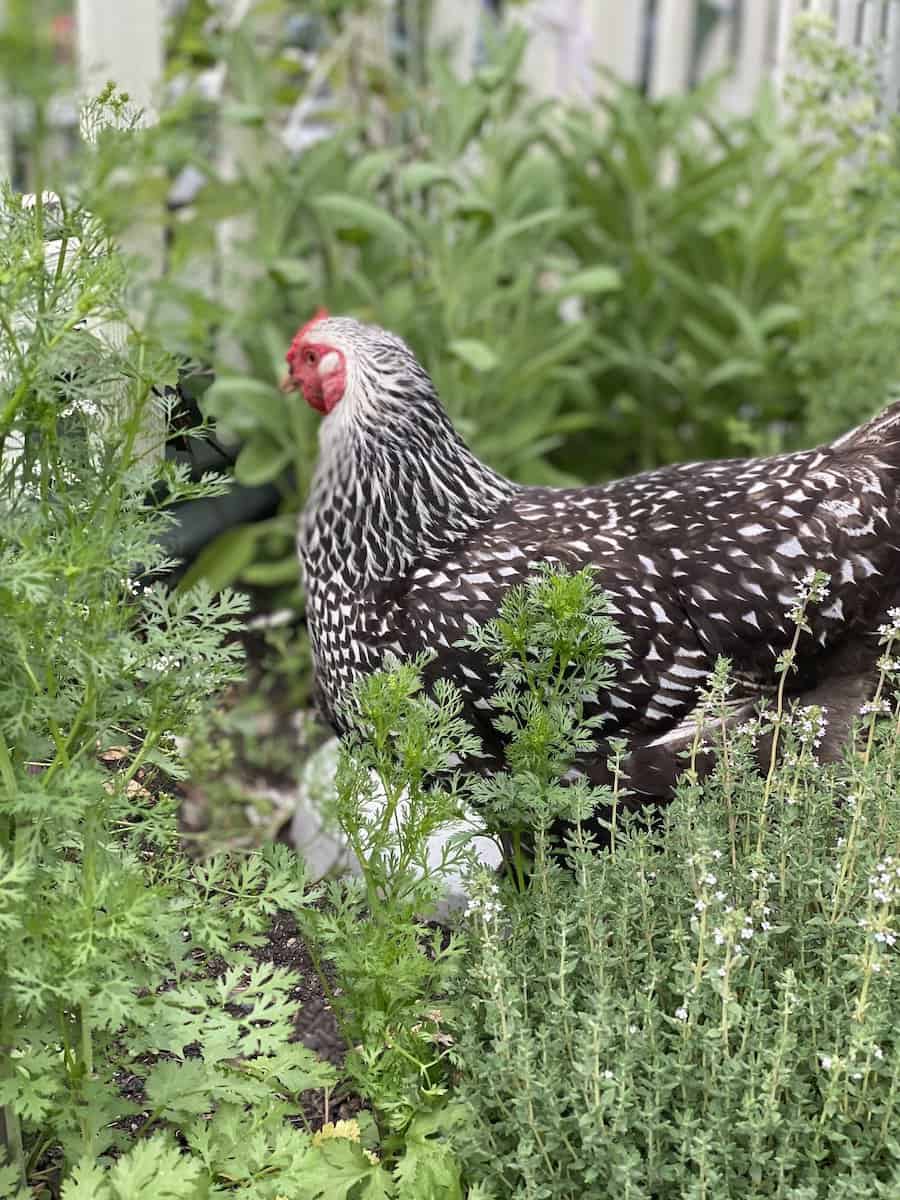
Community and Legal Considerations
Finally, you need to be aware of the community and legal considerations when raising backyard chickens. We should check our local laws and regulations to make sure that we are allowed to keep chickens, and that we comply with any zoning, noise, and sanitation requirements. We should also be considerate of our neighbors and try to minimize any negative impact that our chickens may have on them, such as noise, odor, or waste.
One way to build a positive relationship with your community is to share your knowledge and experience with others who are interested in raising chickens. You can join local poultry clubs (I’ve found them on Facebook), attend workshops and classes, or even start a backyard chicken meetup. By doing so, you can not only help others but also learn from them and build a supportive network of chicken enthusiasts.
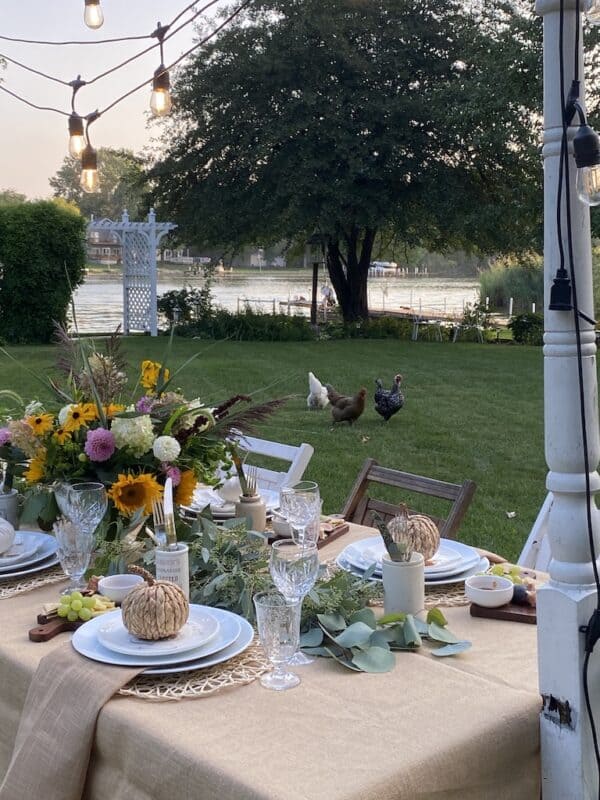
In Conclusion
In conclusion, by following these advanced tips, you can improve the health, productivity, and sustainability of your backyard flock, while also being mindful of your community and legal responsibilities. With some patience, creativity, and hard work, we can raise happy and healthy chickens that provide us with delicious eggs and also enrich our lives in many other ways.
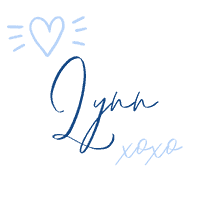

Meet Me
My name is Lynn. I live in the suburbs of Chicago in a 1,300 sq. ft. home with my Handy husband, Keith.
I’m an open book about my life on my blog. You can find out more about me by visiting my About page.


A great way to save this idea is to add it to one of your Pinterest boards. You can find the pin button on the top left of the photo when you click on it. Also, don’t forget to follow me on Pinterest







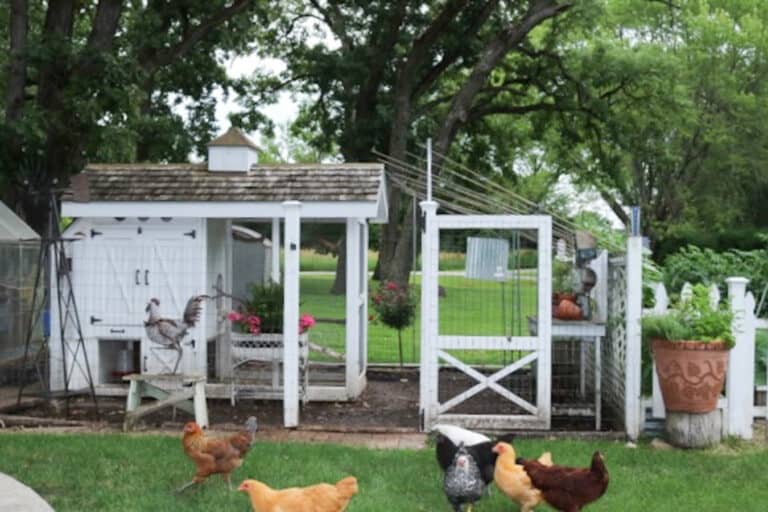
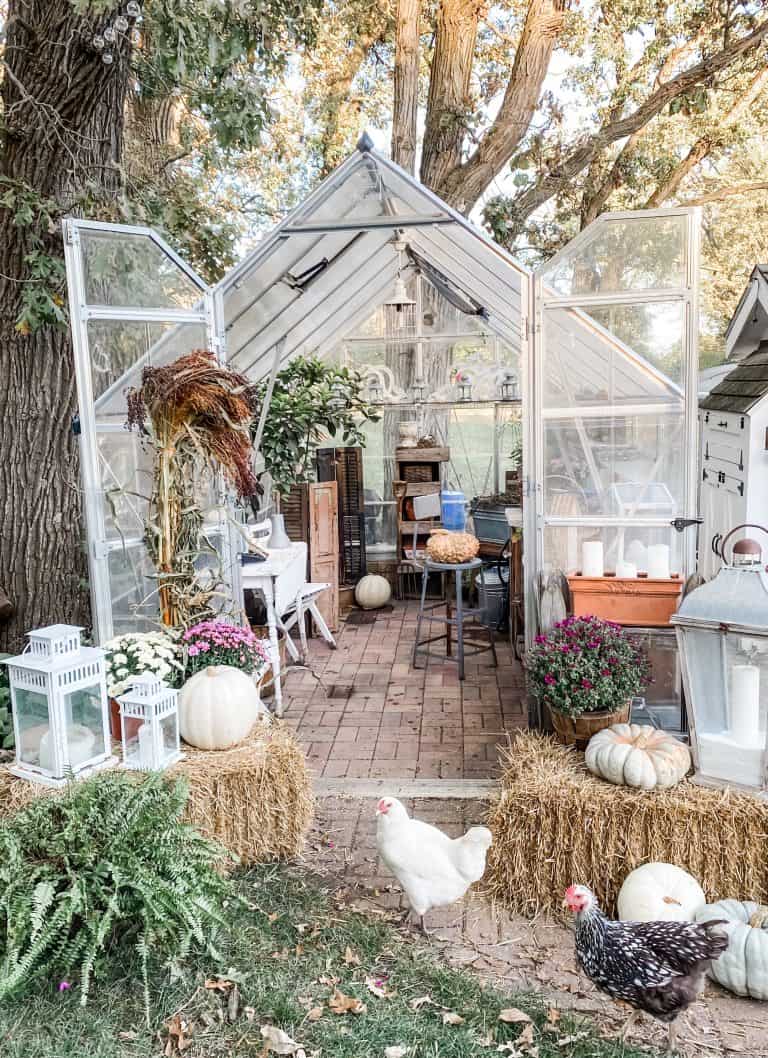


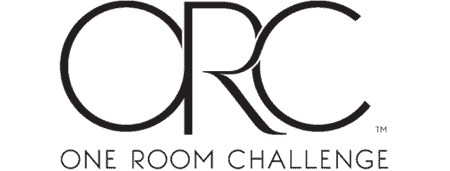











I absolutely loved having chickens. They were so friendly. I miss ours. Your coop is adorable! Hugs to you.
I can’t believe you don’t have chickens on that beautiful farm?
Wow, Lynn! It’s been a little voice in the back of my mind for years. You almost had me ready to broach the subject until you said two of your ladies were victims of raccoons. We have raccoons, bobcats, coyotes, and lots of birds of prey here. I think I’d get too attached and be up all night worrying! There are a couple coops in our neighborhood but I’ll have to live vicariously through them! We’d probably successfully attract every palm rat in a two mile radius! Your coop is beautiful!
If you have a safe coop, they will be fine. Ours are locked in their coop every night. The two that were victims, unfortunately, happened when we were on vacation and weren’t being watched the way we watched them. We have all kinds of wildlife too. We have coyotes, wolves, raccoons, and lots of birds of prey as well. In the 10+ years, we’ve had them, those are the only two we’ve lost.